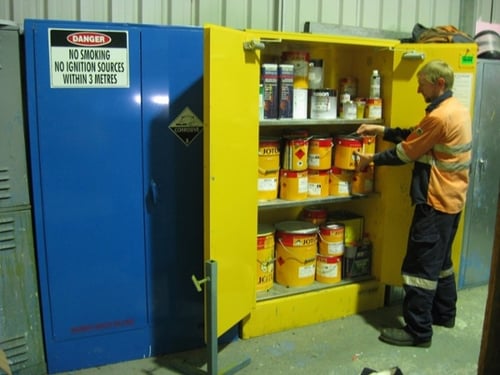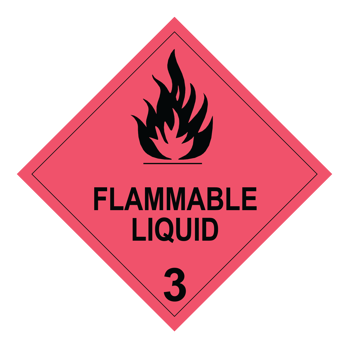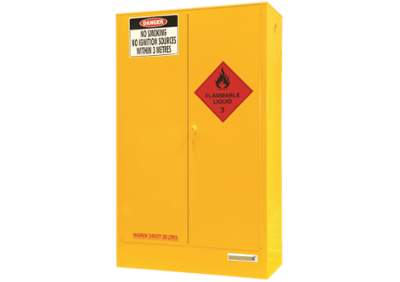If you’re in a New South Wales business that carries Class 3 Flammable Liquids, then this blog is made for you. Here, we’ll be breaking down the key legislation and regulatory documents that you must comply with in NSW. We’ll also be listing many of the essential resources that can help you keep your flammable liquids safe and compliant.
But first, let’s take a look at the legislative framework that governs safety at all NSW workplaces.
‘Harmonised’ WHS Legislation
Have you heard the buzzword ‘harmonised’ and wondered what it meant? Well, you’re not alone. In early 2012, WHS legislation right across Australia was harmonised. This means that each of the 7 states and 2 territories began adapting their WHS laws to adhere to a consistent model WHS Act and Regulation which was developed by Safe Work Australia.
While each state of Australia does issue and administer their own work health and safety laws, WHS compliance and enforcement are effectively the same due to the adoption of harmonised legislation. In a nutshell, harmonised legislation has streamlined WHS compliance and enforcement across the country and provided a framework for every business – regardless of where they operate within Australia.
Example: Section 39 Provision of information, training and instruction, is exactly the same in the Model WHS Regulations as well as the Work Health and Safety Regulation 2017 which operates in NSW. The clauses are identical, and the penalties are the same.

By adopting harmonised legislation, businesses across the country are effectively subject to the same WHS compliance requirements.
Nationally harmonised WHS legislation means that safety standards are uniform, and enforcement is consistent in every state that adopted the Model WHS Legislation. This makes compliance and administration more efficient for workplaces, as well as government.
Work Health and Safety In NSW
Work health and safety in the state of NSW is administered and enforced by SafeWork NSW. The nationally harmonised legislation we mentioned earlier was officially adopted state-wide in January 2012.
This harmonised WHS legislation is administered through the following state laws:
- Work Health and Safety Act 2011 - the mainframe of WHS legislation in NSW and sets the mandatory obligations of everyone who owns, works, or interacts with a workplace. Under the WHS Act you must ensure that the flammable liquids you carry at the workplace do not risk the health and safety of your workers, other people, and the surrounding environment.
- Work Health and Safety Regulation 2017 - the WHS Regulation in NSW set out the licences, records and documents, warning placards, labels, chemical restrictions and other hazard controls that help you fulfil your obligations under the WHS Act. Two specific requirements of the Regulation that especially relate to flammable liquids are implementing risk controls (according to the Hierarchy of Controls) and addressing fire and explosion hazards.
But what does this mean for employers, businesses and workers who must comply with these laws? Let’s have a look at the general legal obligations that all NSW and Australian businesses must comply with.
Legal Obligations For Employers and Businesses
Under work health and safety laws, every NSW employer or business has a specific obligation to ensure that obligations under NSW health and safety laws are met.
Employers and businesses must ensure that workers, volunteers and visitors are safe at work through continual and comprehensive ‘due diligence’. This means that reasonable steps must be taken by employers and businesses to make sure that compliance is achieved — and maintained — in the workplace.

Employers, businesses and staff all have a legal obligation to ensure that a safe working environment is maintained.
Worker Obligations
Under work health and safety laws, workers also have legal obligations whether they’re classed as an employee, apprentice, volunteer, contractor or even sub-contractor. The safety responsibilities of workers encompass taking care of themselves and others at work to ensure health and safety obligations are met.
This includes:
- Working in a safe manner
- Following instructions
- Making sure that they know how to properly perform tasks
- Using PPE in the correct way
- Reporting injuries or unsafe situations to a supervisor or health and safety representative
While these obligations are fundamental to our work health and safety laws, there are many considerations to make when determining how to safely handle and store flammable liquids in the workplace. To help businesses understand exactly how to achieve compliance, there are a range of resources that are available to assist with workplace risk reduction.
We’ll go into further detail about some of these documents in the next section of the blog.
 There are many resources that can help NSW businesses minimise risks associated with Class 3 Flammable Liquids.
There are many resources that can help NSW businesses minimise risks associated with Class 3 Flammable Liquids.
Relevant Codes of Practice in NSW
WHS Codes of Practice are official guides to minimising specific risks or workplace hazards. The following Codes of Practices are approved under WHS legislation in NSW and may apply to your workplace if you use, handle or store Class 3 Flammable liquids:
REMEMBER: Codes of Practice are also harmonised to national standards.
- Managing risks of hazardous chemicals in the workplace - requirement to identify the hazards associated with each of the flammable liquids present at the workplace, then assess their potential to create a fire, explosion, or health hazard. This Code of Practice also outlines in detail your obligation to eliminate (or minimise) chemical hazards as far as possible.
- Labelling of workplace hazardous chemicals - requirement to ensure packaged flammable liquids (as well as portable containers) have correct labels.
- First aid in the workplace - requirement to install safety showers and eyewash stations in areas where workers handle flammable liquids that are corrosive or otherwise hazardous to the skin and eyes.
- Confined spaces - requirement to ensure vapours from flammable liquids don’t create asphyxiation, fire, or explosion hazards.
- Spray painting and powder coating - requirement to manage the increased risk of fires and explosions because of the amount of solvent vapour in the air.
- Managing the work environment and facilities - requirement to ensure the physical aspects of the work environment are compatible with the flammable liquids you have onsite. For example: having good lighting so workers can read chemical labels; having sufficient ventilation so workers aren’t affected by fuel vapours or fumes; having somewhere for workers to store their personal items so they don’t inadvertently bring potential ignition sources (ie, mobile phones) into flammable liquids storage areas.
- Construction work - requirement to ensure flammable liquids are stored safely and correctly so they don’t create flammable or explosive atmospheres on construction sites.
It is important to remember that you must abide by an approved Code of Practice that applies to your industry or employment sector — unless you have another proven way of managing the flammable liquids their hazards.
Additional Compliance Documents
There are other compliance documents that will dictate how your workplace uses, handles, and stores flammable liquids. Familiarising yourself with these additional documents will help you increase your knowledge of flammable liquids safety and assist you in determining your handling and storage practices.
Referring to documents, such as the Australian Standard AS 1940:2017, can help you create compliant handling and storage procedures.
These documents include:
- Australian Safety Standards - are guidance documents that provide information about specific chemicals, hazards, installations, machinery and industries. As a minimum you should be consulting AS 1940:2017 – The storage and handling of flammable and combustible liquids.
- Workplace Exposure Standards for Airborne Contaminants - sets the limits for chemical concentrations in the breathing zones of workers.
- Australian Dangerous Goods Code (ADG Code) — details labelling, signage, segregation and transport requirements for Class 3 Flammable Liquids and other Dangerous Goods.
- Safety Data Sheets (SDSs) — issued by the chemical manufacturer and outlines the hazards, chemical properties, handling and storage information for the chemical.
IMPORTANT: Some of these documents are specified in the WHS legislation and compliance is mandatory. Eg, Workplace Exposure Standards, ADG Code, Safety Data Sheets (SDSs). Check the SafeWork NSW website for legislation, Codes of Practice and other guidance materials.
Understanding Your Compliance Obligations In NSW
Thanks for reading our blog on how to keep flammable liquids safe and compliant in NSW. As we’ve explained, there’s a wide range of available resources that can help businesses achieve compliance and meet their obligations under the WHS Act and Regulation in NSW.
Like to learn more about flammable liquids safety and compliance? We also have created an invaluable eBook which will help you reduce your compliance risk. Essential Considerations When Storing Flammable Liquids Indoors will introduce you to our 4-step risk control methodology which can be easily applied to any workplace that handles and stores flammable liquids. Why not grab your free copy today by simply clicking on the image below?
Like to learn more?
Read our related posts on compliance in Australia:
Flammable Liquids and Dangerous Goods Compliance in Victoria
Flammable Liquids Compliance and the 5-Year Strategic Plan for WHS in QLD
OHS Compliance for Class 3 Flammable Liquids in Western Australia
Flammable Liquids: Legislation and Compliance in Northern Territory
Joining the team as a Dangerous Goods Storage Consultant, Melissa Hampton became Storemasta's Marketing Manager in late 2021. With extensive knowledge and experience in chemical compliance, Melissa is responsible for leading the Marketing team and helping shape their marketing strategy. In her spare time, you can find Melissa hiking, swimming and enjoying the great outdoors in beautiful north-west Tasmania.

